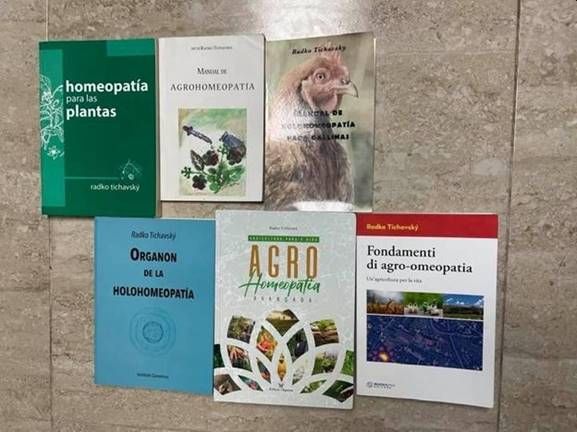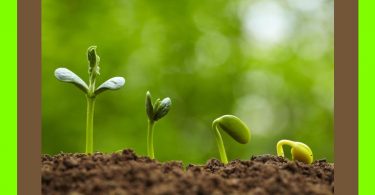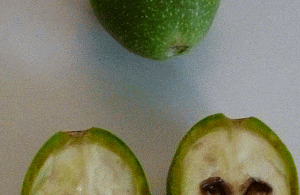New Video from Dr. Radko Tichavsky!
In this video, renowned Agrohomeopath Dr. Radko Tichavsky explains Holohomeopathy, the more advanced method of agrohomeopathy: https://youtu.be/GUUoO6Lt-U8 (English subtitles)
* Editor’s note: JT (Jenichen / Tichavsky) potency is often mentioned in these columns. It is a centesimal dilution followed by 500 succussions or five hundred continuous turns with a wooden stick to the right and 500 turns to the left (if handling larger volumes). The JT potency frequently has a better reaction in plants and it is very important in preparation of live bionosodes.
Hello Dr. Tichavsky,
What remedies should I use when transplanting? I have thornless blackberries, elderberry canes, a lilac bush and some herbs from last year’s crop and all are going to be moved to a different location. We live in San Fernando, California (91340). We get 17 inches of rain, on average, per year. Summer High: July high is 87 degrees and the low is in January at 47 degrees.
Thank you
Stephen
Dr. Radko Tichavsky:
Dear Stephen,
Rooting agents and adaptogens are important remedies in plant transplantation, but beyond the mechanical application of homoeopathic remedies, the plant must be prepared before the transfer to its new site. First make a living bionosode of the soil of the place where you are going to move the plants.
Collect some of the soil from the destination site, dissolve it in non-chlorinated water, and dynamize it to 3 JT potency.* Water the soil around the plants in their original location. In this way you will prepare your plants to the change of microbiota, inoculating the microbiota of the new site and you will facilitate their adaptation to the new conditions.
Afterwards, make circular incisions in the soil with a shovel around each plant (without removing the plant from the soil). This will cut some roots and give the plant time to heal them. After this apply Arnica montana 6 CH in irrigation.
After a week you can mark the cuts you have made in the soil around the plants and remove them with all the soil and place them in bags and move them as soon as possible to avoid damage by aeration of the roots.
Once the transfer is done, apply Zingiber officinalis at 6 JT potency (made from the mother tincture of Ginger rhizome). This homeopathic preparation contains melatonin, a hormone that governs other hormones such as auxins, maximizes rooting and root proliferation after transplanting. The homeopathic remedy of Zingiber officinalis should be applied once a week at 8 pm in the evening, when melatonin works at its maximum potency.
Greetings Dr. Tichavsky,
Can you suggest something for our Red Currant Bush (pic below). Could it be aphids or rust fungus. We live in Canton, Georgia ( U.S.) 30114. Summers are hot and humid; the winters are short, cold, and wet. The temperature varies from 34°F to 88°F and is rarely below 22°F or above 94°.

Thank you
Maryann
Dr. Radko Tichavsky:
Hello Marian,
Minimize the nitrogen fertilizing (either synthetic or organic), and apply Boswellia sacra 6 CH by spraying, made from the alcoholic mother tincture of common frankincense. Pulverize the incense and soak it in alcohol at 30% for one week, then elaborate the 3 JT potency *.
That is to say dilute one part of the mother tincture in 99 parts of water and make 500 vigorous succussions thus elaborating the 1 JT potency, repeat the process until you reach the 3 JT potency, then put 20 drops per liter of water and spray in the evenings on your plants. The application can be repeated once a week until the symptomatology disappears and the new leaves will come out healthy.
Dear Dr. Tichavsky,
I clearly have a squash vine borer in this plant. How do I save it? How do I protect the rest of my squash? We’re in Jackson, Mississippi ( U.S.) 39202. We get 54 inches of rain per year. High temp is in July, 92 degrees, winter low is January at 36.
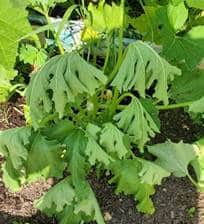
Thank you
Helena
Dr. Radko Tichavsky:
Dear Helena,
To eliminate Squash Vine Borer (Melittia satyriniformis) from your crops you should apply Berberis vulgaris at 6 CH potency in irrigation.
Hello Dr. Tichavsky,
We are starting to see Mistletoe in our Oak trees. We had a lot of damage from the ice storm in 2021 and as a result, the trees have been weakened which I think is helping the mistletoe take control. Would a remedy made from Mistletoe work? If not, what might I try?
Thank you
Francis
Dr. Radko Tichavsky:
Hi Francis,
The increased proliferation of mistletoe on trees is due to multiple causes, where climatic changes are of primary importance. Birds in the forest usually feed on the fruits of the shrubs and the change of climate probably disappeared many fruits in the shrubs, then the birds began to feed on their secondary food source, the seeds of mistletoe, which they spread in the crowns of other trees (both on their bodies and in their droppings).
This explains why the methods of pruning the branches affected by the mistletoe have no lasting effect. As long as food is scarce for the birds they will consume and disperse their seeds in the forest.
Fungi, mainly Phaeobotryosphaeria spp. are used to control this parasitic plant. The fungus appears as dark spots or blotches on mistletoe leaves. Collect some of these leaves and liquefy them in a liter of carbonated water and prepare bionosode vivo at 4 JT* potency and spray on the tops of affected mistletoe trees.
Another way to control glanders is by means of bacteria such as Bacillus megaterium, Bacillus pumilus, both of which are found in Aloe vera. You can apply live bionosode from the gel of Aloe vera leaves at 4 JT strength sprayed on the mistletoe to reduce its vigor and eliminate it.
Dear Dr. Tichavsky,
The fruit on our Gooseberry Bush looks like it has a fungus of some sort although the rest of plant looks okay. Any suggestions?
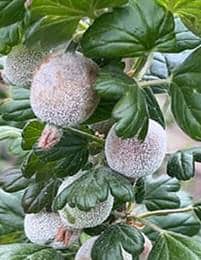
Thank you
Horace
Dr. Radko Tichavsky:
Dear Horace,
The condition on your Goosberry Bush is powdery mildew (Podosphaera sp.). You can use Kalium carbonicum at 6 CH potency to control it, alternated with Sulphur 6 CH (this should be applied after sunset, as in combination with the sun’s rays it can produce burns on the plant.)
Dear Dr. Tichavsky,
We currently have a problem with our crop of Pomegranate. It’s called Pomegranate Wilt Complex. Can you suggest a holistic way to deal with this? I live in Maharashtra, India. We have a typical monsoon climate, with hot, rainy and cold weather seasons. Tropical conditions exist all over the state. April and May are the hottest months. The mailing code here is 413527.
Thank you
Hassan
Dr. Radko Tichavsky:
Dear Hassan,
In Pomegranate to control Wilt Complex (Ceratocystis fimbriata in combination with Meloidogyne incognita) you can apply Bacillus tequilensis in the form of live bionosode ala potency 4 JT.* This bacterium can be isolated from the seeds of plants of any species of Agave. B. Tequilensis promotes plant growth and increases plant biomass, even in nutrient-starved soils, and eliminates ceratocystis fimbriata.
To control Meloidogyne incognita apply Trichoderma harzianum, Trichoderma viride or Trichoderma asperelum in live bionosode at 4 JT potency.You can also prepare garlic chili and cinnamon mother tincture and dynamize it at 4 JT potency with Opuntia indica slime as an adjuvant (1 liter per 100 liters of the homeopathic preparation).
BOOKS ON HOLOHOMEOPATHY
Many readers asked about Dr. Radko Tichavsky’s books. Below is a photo of them. They are available in Spanish, Italian and Portuguese. For ordering or information: [email protected]
